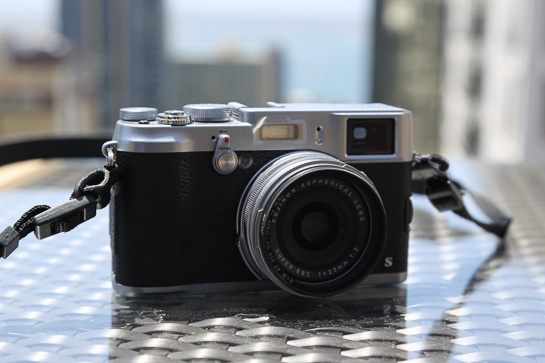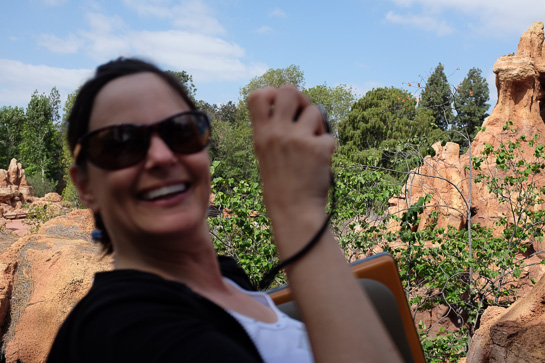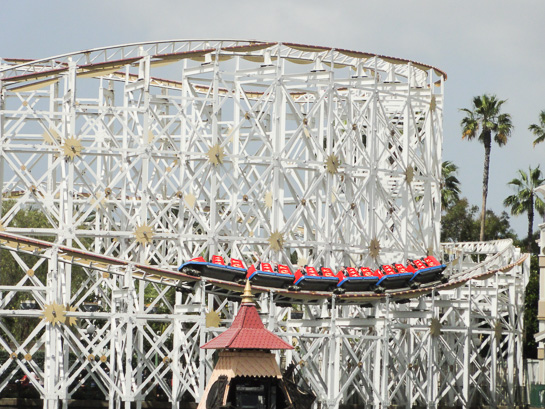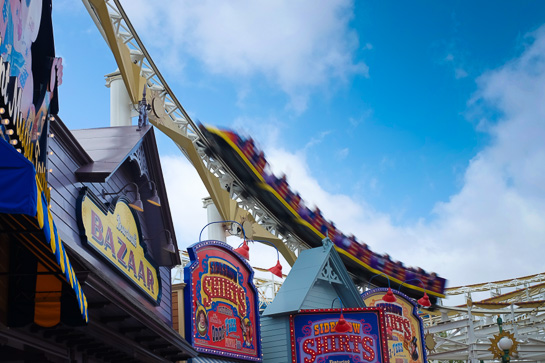 In December I wrote about traveling with the Fuji X100S camera for a week, and how it was both liberating and occasionally frustrating.
In December I wrote about traveling with the Fuji X100S camera for a week, and how it was both liberating and occasionally frustrating.
After using the camera sporadically for six months, and and after another recent heavy-use trip, I’d like to share some revised thoughts now that I know the camera a bit better.
I’d especially like to highlight two important features that I didn’t get to use in my previous Hawaii trip, and which I think are strong advantages of this camera.
First, the Bad Stuff
Before getting to the good stuff, let me address the biggest problem of this camera, which I wrote about previously:
It has a tendency to sometimes miss the focus on your foreground subject, and focus on the background instead.
Here’s an example (if the composition seems weird, well, we were on a roller coaster). The focus point was on her face:
It doesn’t do this all the time, of course, which would be intolerable. It does it just enough to be annoying.
And in my experience, it happens most often when you have a well-lit, high-contrast background behind a low-contrast or poorly lit subject.
Compare the photo below, taken one second later with the subject in bright light, the Fuji nailed the focus:
It seems that in the former conditions, the Fuji “sees” the background better than it sees the subject, and locks in on it instead.
This is understandable, but if other camera makers can avoid this problem, Fuji should be able to also.
And it’s not just my camera. Since my previous review I’ve heard from countless other X100S owners frustrated by the same problem.
So with this seemingly serious flaw, why is this such a popular camera?
Well, because it’s such a damn good camera in so many other ways that people still love to shoot with it.
I won’t repeat everything I said in my previous review about its sharpness and low-light ability (both are amazing).
Instead, I’ll mention two more good features that I hadn’t tested last time I wrote about the Fuji.
Built-In 3-Stop ND Filter
On my DLSR cameras I sometimes use ND filters to knock down the light on a bright day. Maybe I want a slower shutter speed in order to use a wide aperture for shallow depth of field. Or maybe I want to bring the shutter speed within my camera’s maximum flash sync speed. Or maybe I want to achieve a special blur effect like the common soft waterfall or ocean blur seen in landscape photos.
But in all these cases, putting the ND filter on the camera and fussing around with it is a hassle. (And that’s assuming I even have it with me.)
The Fuji, on the other hands, has a built-in 3-stop ND filter that you simply turn on by a menu selection.
How fast and easy!
Suddenly I find myself thinking on sunny days “What could I do here with a slower shutter?” or “What could I do here with shallow depth-of-field?”
Here’s an example from a trip to Disneyland last week, where Julie and I were shooting lessons for an upcoming course on travel photography (don’t hold your breath — watch for it in 2015).
Shooting this roller-coaster in bright sunlight yields the usual results: completely frozen motion at a high shutter speed.
But this is the Fuji, right? So why not just turn on the ND filter and show some motion?
Three stops means three halvings of the shutter speed. So if my shutter speed was 1/800 cut it in half once to 1/400, again to 1/200, and again to 1/100.
At 1/100 you can see some blur on a roller-coaster!
And now that we’re in the ballpark, by tweaking the aperture and shutter and ISO we can get just the amount of blur we want.
This filter is also great for sunny-day portraits where you want a nice soft background. Turn on the filter, open up the aperture by three stops, and get a nice shallow depth-of-field.
And with the Fuji’s amazing flash sync speed (1/1000 at f/2 and any speed at smaller apertures) you can introduce on-camera or off-camera flash, combined with the ND filter, for well-lit shallow-focus portraits. More on that in a future write-up.
Great Low-Light Video
In my previous review I had not yet had a chance to fully test the Fuji’s video capabilities.
Now I’m pleased to report that the light-loving APS-C sensor that makes such great still photos also makes great videos as well. This thing just gobbles up the light, even in the most dim surroundings.
Now, if you’re a serious video shooter, the Fuji is not going to become your video workhorse, because it doesn’t give you full manual control. When you enter video mode, the camera basically goes full auto, making its own choices for shutter, aperture, and ISO. (The good news is, it does a pretty good job of choosing its settings.)
So the Fuji is no substitute for a DSLR when you want to have full control over the look of your video.
But if you compare the video from the Fuji to the camera that it is probably replacing in your pocket or purse, then it wins hands down.
Because of its large sensor, the Fuji easily outperforms your standard point-and-shoot camera or iphone for video in low light. And in bright light it gives you depth-of-field that you could never get on one of those small-sensor pocket cameras.
In the video below you’ll see some twilight clips that show how in low light the Fuji outperforms a standard point-and-shoot camera, the Sony Cyber-Shot DSC-HX5V. The Sony is a good camera, but its tiny sensor just can’t compete with the Fuji.
Final Thoughts
My feelings about the X100S remain mixed, but mostly positive.
Because of its annoying focus problem, after my initial review six months ago, I had intended to sell it on eBay and put the money toward a different mirrorless camera.
But for some reason, I just can’t seem to part with the thing
And now that I’ve gotten to know the built-in ND filter and low-light video ability, I’ve found two more reasons to hold onto the Fuji.
About 95% of the time, it’s the amazing pocket camera you’ve always dreamed of (assuming you have a big pocket). And the other 5% of the time, when it’s missing the focus on your subject, it seems a small price to pay for all its virtues.
If you’re a serious camera buff who loves manual controls and loves having a camera that will challenge you to keep learning and growing with it for years, then I still recommend this camera.
And if actions speak louder than words, then perhaps the best way to conclude is by noting that when traveling with several cameras at our disposal, despite its flaws, Julie and I were always fighting over who got to shoot with the Fuji. That says something.
Check the current price on Amazon.com
Price the Fuji X100S on Amazon.com
Optional Equipment that I added to mine
B+W 49mm Clear UV Haze Filter (to protect the lens)
JX100 Lens Hood/Adapter Ring (buy this for $14 or the Fuji version for $90)
As always, if you shop from my Amazon affiliate links you buy me a beer!







I have the ND filter set to the Fn button. I love that feature. Also love the fact that I don’t have to worry about using a high shutter speed when using flash. On my recent trip to Paris and London, I found that I used the X100s a lot more than the X-Pro1 simply because it was always with me. The X-Pro1 came out about half the time. I still find that back button focusing gives me almost 100% focusing accuracy but I have practiced with it a lot over the last few months and almost instinctively know where to put the square to get the focus in bad light.
I should clarify my last post about flash and shutter speed. I love the fact that I can use a high shutter speed when using flash.
hi Phil i have the fujix100 , the command dial is an issue if your not carefull you can click on the wrong option very easily , I find it a bit footary (scottish slang)
And its not a camera you can use in a hurry . But i have to say despite these
little things i Just Love it . The quality of the pictures is amazing and theres something magical about the colours it produces . Im constantly amazed by how sharp and how much detail the fixed 23mm lens takes in , even when you zoom in to subject at a distance its amazing . I love it .
Alan, agreed, there is something unique about the Fuji colors, and I especially love what it does with skin tones. It’s JPG processing algorithm is so good that I almost never shoot RAW on this camera. The Fuji engineers achieved a miracle with the color processing.
hi phil,since there is no way to attach an external flash,don’t you think you cannot avoid redeyes and unflattering portrait images with the built-in-flash where yoy may not be able to use a diffuser and you would not able to bounce the flash rither.
joseph premanandan
I have this small wonder just over 4 months and I’m amazed. My old Canon 20d and 5d did not use since. I’m often in nature and mountains and I’m releved not to carry heavy equipment. One thing I’m using a lot is bracketing for later hdr process. Doing it out of hand, no tripod. Works perfectly! And panoramas! Great! Cause I use manual focus, don’t have focusing problem. I love Fuji x100s!
thanks phil i appreciated the update on the fujifilm 100xs. i still have not decided between the Fuji and the sony Rx1. the cost of the Rx1 is a definite consideration. i have reviewed your comments on the Fuji, but wondered if you have ever tried the Sony Rx1. appreciate your opinion and comments. thanks jeff
Great review. Thanks. I have the x100s and have noticed the focus problem too. But still an awesome camera!
Interesting reviews? Agree with your focus point observation and this carries through onto the X100T which I just bought. It’s a beautiful, tactile and rewarding camera but Fuji are missing a couple of tricks: 1) It needs a proper explanatory manual that details the options and functions properly: the focus issue needs to be resolved: it is so menu driven that it would benefit from a function button option to record your personal base settings so that you can jump right back to your known starting position. red Josef’s comments above concerning remote flash, I have been testing my Pocket Wizard PlusX units on this and they work well, as does the new WiFi and tethered shooting through the Fuji Remote App. Thanks